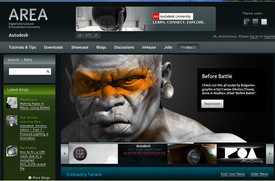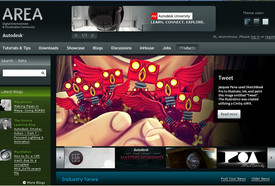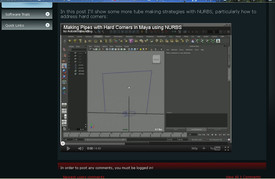Creating an Online Community of Users Within the Classroom
A lot is written about the networking nature of technology. I would like to talk about how this has played out in my classes. I teach computer animation using software called Maya, and I also teach Photoshop in AEC courses at Cégep de Bois-de-Boulogne and at Collège André-Grasset.
Maya is complex 3D software using animation, modeling and dynamics which are physics simulations. It’s pretty much the standard in the film industry although there is other software. What is interesting is that information technology is not as essential to teaching an application such as Maya as one would think, but it is acquiring a role outside of the classroom.

Area Digital Entertainment and Visualization Community
Often I teach traditional skills starting on paper and then scan them into Photoshop creating images which are then assembled. Although I use a data projector to illustrate aspects of Maya, I actually just asked for a whiteboard in my classroom because a lot of the things that I demonstrate are easier written by hand. I like to draw, and I like to draw quickly. To illustrate a point just as fast as I can requires drawing it by hand as opposed to drawing it on the computer.

Inspiring Work is featured on the home page
At times, the process of teaching a student to become an animator depends on the background of the student. If the student is a good artist but has no computer experience, they may need a lot of technical training, whereas some students arrive completely computer literate, but lacking in visual arts skills. In our courses, we try to find a mix that can accommodate these two extremes.
This mix of skills creates a certain synergy between the students. They act as guides to each other, and classes function as a group activity. People are sometimes reticent to share their work because of shyness and lack of confidence. Other students are over-confident, and too much ego makes them protective of their work and technique. In the end, however, it’s better if everyone has access to this knowledge and in return gets something from everyone else. We are building a community of users within the classroom.
Some students arrive with a great deal of experience to share. Maybe they were in architecture before; maybe they were graphic designers. I teach continuing education, so most of my students have a background in some kind of art or technology already. Some students have used Maya before, and some have experience in other animation software such as Blender which is shareware.

Student contributed tutorials promote learning
The students who come in with very few computer skills find it very difficult at the beginning, but often these students, who have a strong artistic background, surprise themselves after a few weeks or months. Once it all starts to make sense, and they can make the connections, they find that working with the computer is not so difficult, and their progress pushes them further.
I, myself, got a lot of my experience in a very informal manner. I was working for the software company Alias which originally designed Maya. When I arrived there as my first job in the industry, I had nothing but smarter, more knowledgeable, more experienced people using the software surrounding me as well as the people who make the software. My learning curve was facilitated by a lot of coaching.
Even though I show the students a great many things over the course of a year I still encourage them to look at other tutorials and look for books on the subject.
Maya’s three year student license then allows these students to keep on developing their skills once they leave my classroom and allows them to keep on helping one another as well. I think of this software as a unifying link which will allow students to communicate in order to continue to sharpen their skills. I try to teach them to teach themselves and each other from the start. I show them where the software’s features are, but I leave it up to them to make the connection on how to use these elements, to be imaginative with them. At its heart, the software is based on cubes, spheres and triangles. Working from these to more complex images is the same process on paper as it is on the computer. They can get the basic understanding of how these forms come together, and make more complex things on paper before learning how this process functions on the computer. Students find that they have complementary skills and learn to communicate meaningfully as they work on their projects.
The program is 15 months here at Bois-de-Boulogne, so after the students do their internships, if they are still not able to find a job in the industry they can continue to work at home; improving their demo reel, getting help from fellow students through social media as well through sites such as the Area at Autodesk which is a community page for Autodesk users filled with free tutorials, tips and tricks. There is a great deal of information online at various sites where individuals offer free tutorials as well. The idea is for the student to constantly grow their knowledge of the world of 3D animation inside and outside the classroom and to share this knowledge with others.
Even though I show the students a great many things over the course of a year I still encourage them to look at other tutorials and look for books on the subject. To view one of my classes “Making Movies at Home with Maya” create an account and login to the Area at Autodesk. Being an artist is a job that often lasts your whole life; I’m still a student myself.
Are your students forming online communities of users to sharpen their skills? Does the mix of student skills in your class help or hurt creating an online community of practice?

